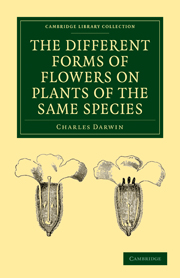Book contents
- Frontmatter
- Contents
- INTRODUCTION
- CHAPTER I HETEROSTYLED DIMORPHIC PLANTS: PRIMTULACEÆ
- CHAPTER II HYBRID PRIMULAS
- CHAPTER III HETEROSTYLED DIMORPHIC PLANTS–continued.
- CHAPTER IV HETEROSTYLED TRIMORPHIC PLANTS
- CHAPTER V ILLEGITIMATE OFFSPRING OF HETEROSTYLED PLANTS
- CHAPTER VI CONCLUDING REMARKS ON HETEROSTYLED PLANTS
- CHAPTER VII POLYGAMOUS, DIŒCTOUS, AND GYNO-DIŒCIOUS PLANTS
- CHAPTER VIII CLEISTOGAMIO FLOWERS
- INDEX
CHAPTER VIII - CLEISTOGAMIO FLOWERS
Published online by Cambridge University Press: 05 July 2011
- Frontmatter
- Contents
- INTRODUCTION
- CHAPTER I HETEROSTYLED DIMORPHIC PLANTS: PRIMTULACEÆ
- CHAPTER II HYBRID PRIMULAS
- CHAPTER III HETEROSTYLED DIMORPHIC PLANTS–continued.
- CHAPTER IV HETEROSTYLED TRIMORPHIC PLANTS
- CHAPTER V ILLEGITIMATE OFFSPRING OF HETEROSTYLED PLANTS
- CHAPTER VI CONCLUDING REMARKS ON HETEROSTYLED PLANTS
- CHAPTER VII POLYGAMOUS, DIŒCTOUS, AND GYNO-DIŒCIOUS PLANTS
- CHAPTER VIII CLEISTOGAMIO FLOWERS
- INDEX
Summary
It was known even before the time of Linnæus that certain plants produced two kinds of flowers, ordinary open, and minute closed ones; and this fact formerly gave rise to warm controversies about the sexuality of plants. These closed flowers have been appropriately named cleistogamic by Dr. Kuhn. They are remarkable from their small size and from never opening, so that they resemble buds; their petals are rudimentary or quite aborted; their stamens are often reduced in number, with the anthers of very small size, containing few pollen-grains, which have remarkably thin transparent coats, and generally emit their tubes whilst still enclosed within the anthercells; and, lastly, the pistil is much reduced in size, with the stigma in some cases hardly at all developed. These flowers do not secrete nectar or emit any odour; from their small size, as well as from the corolla being rudimentary, they are singularly inconspicuous. Consequently insects do not visit them; nor if they did, could they find an entrance. Such flowers are therefore invariably self-fertilised; yet they produce an abundance of seed. In several cases the young capsules bury themselves beneath the ground, and the seeds are there matured. These flowers are developed before, or after, or simultaneously with the perfect ones. Their development seems to be largely governed by the conditions to which the plants are exposed, for during certain seasons or in certain localities only cleistogamic or only perfect flowers are produced.
- Type
- Chapter
- Information
- The Different Forms of Flowers on Plants of the Same Species , pp. 310 - 345Publisher: Cambridge University PressPrint publication year: 2010First published in: 1877



